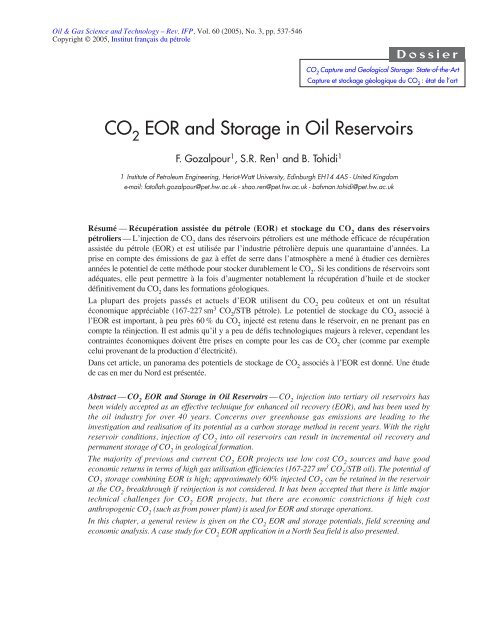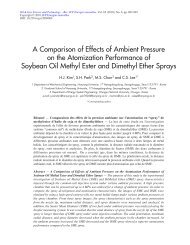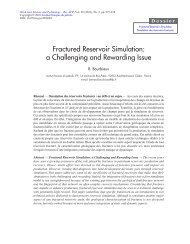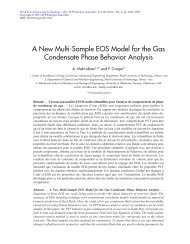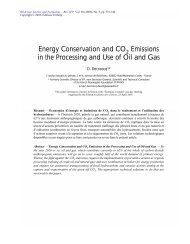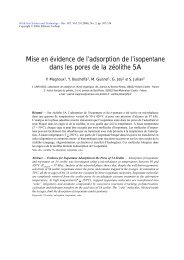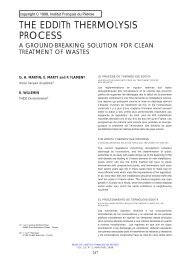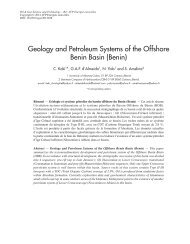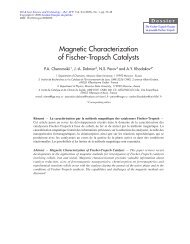CO2 EOR AND STORAGE IN OIL RESERVOIRS - Oil & Gas Science ...
CO2 EOR AND STORAGE IN OIL RESERVOIRS - Oil & Gas Science ...
CO2 EOR AND STORAGE IN OIL RESERVOIRS - Oil & Gas Science ...
Create successful ePaper yourself
Turn your PDF publications into a flip-book with our unique Google optimized e-Paper software.
540<strong>Oil</strong> & <strong>Gas</strong> <strong>Science</strong> and Technology – Rev. IFP, Vol. 60 (2005), No. 3Similar volumetric methods were used by ECL Technology(UK) to calculate the net CO 2retained in the reservoirfor different <strong>EOR</strong> operations (ECL Report 5, 2001).For water alternative gas injection (WAG):Net CO 2retained= WAG IOR efficiency*WAG score efficiency*OOIP*WAG <strong>CO2</strong> factor alpha *B o /B gWhere, WAG IOR efficiencyis the targeted incremental oilrecovery factor (% OOIP) produced by a CO 2WAG operation,WAG score efficiencyis a factor between 0 and 1 (it is 1 foran efficiently and fully implemented WAG project). TheWAG <strong>CO2</strong> factor alphavaries between 1 and 2 and is related to thenet CO 2utilisation efficiency when expressed in reservoirvolumes, indicating more gas may be stored in the reservoirthan required for WAG operation.For gravity stable gas injection (GSGI):Net CO 2retained= (GSGI <strong>CO2</strong> factor )*(GSGI score CO 2factor )*OOIP* 0.7*B o/B g(4)GSGI <strong>CO2</strong> factoris the targeted incremental oil recovery byGSGI operations. The GSGI score<strong>CO2</strong> factorallows the user to reducethe injected CO 2volume compared to the potential targetvolume. For a fully implemented project GSGI score<strong>CO2</strong> factor isequal to 1. The factor 0.7 accounts for the fraction of OOIPleft in the formation at the end of gas flood and a smallamount of mobile water also left in the gas swept region. TheGSGI differs from the WAG operation. For GSGI, theamount of CO 2retained is proportional to the reservoir porevolume, rather than the process IOR. More CO 2is needed ina GSGI process, which is favourable for CO 2storage.These expressions can be used for estimating the CO 2storage potential in a CO 2<strong>EOR</strong> project associated with thetargeted incremental oil recovery. The basic assumption isthat the theoretical capacity for CO 2storage in oil reservoirs(3)equal to the volume previously occupied by the produced oiland water. For more accurate predictions, appropriatenumerical reservoir simulations can be used, which mayconsider the effect of water invasion, gravity segregation,reservoir heterogeneity and CO 2dissolution in formationwater (Bachu et al., 2004). In practice, other considerationsneed to be taken into account for CO 2storage, such asreservoir type, depth and size and the safety of the CO 2storage. The low capacity of shallow reservoirs, where CO 2would be in the gas phase, makes them uneconomical forstorage. On the other hand, CO 2storage in very deep reservoirmay also be not economical due to the high cost of compression.The reservoir depth window of 900-3500 m has beenrecommended for CO 2<strong>EOR</strong> and storage (Winter et al., 1993;Bachu et al., 2004). Large reservoirs with high CO 2storagecapacity are favourable considering the unit cost for buildinginfrastructure for CO 2capture, transportation and injection,and the lifespan of the project for long time operations. Thus,most likely, only reservoirs with large CO 2storage capacity(e.g. > 1 Mt) will be considered in the short and medium term.The roughly estimated global potential of CO 2storage usingoil reservoirs is in the range of 41-191 Gt (Lako, 2002).4 RESERVOIR SCREEN<strong>IN</strong>GNot all oil reservoirs are suitable for CO 2<strong>EOR</strong> and storagefor various technical and economic reasons. The followingpreliminary technical evaluations were suggested forselecting oil reservoir for CO 2<strong>EOR</strong> and storage beforeconsidering other economic criteria (Shaw et al., 2002):– screening for <strong>EOR</strong> and storage suitability;– technical ranking of suitable reservoir;– IOR and CO 2storage capacity predictions.Table 2 lists a series of criteria recommended by variousauthors for the technical screening of CO 2<strong>EOR</strong> by miscibleReservoir parameterTABLE 2Screening criteria for application of CO 2miscible flood suggested by various authorsCarcoana Taber& Martin Klins Taber et al.(1982) (1983) (1984) (1997)Depth (m) < 3000 > 700 > 914 i) > 1219; ii) > 1006iii) > 853; iv) > 762Temperature (°C) < 90Pressure (MPa) > 83 > 103Permeability (mD) > 1<strong>Oil</strong> gravity (°API) > 40 > 26 > 30 i) 22-27.9; ii) 28-31.9iii) 32-39.9; iv) > 40Viscosity < 2 < 15 < 12 < 10Fraction of oil remaining > 0.30 > 0.30 > 0.25 > 0.20
F Gozalpour et al. /CO 2<strong>EOR</strong> and Storage in <strong>Oil</strong> Reservoirs541flood. These criteria are based on the optimising reservoirperformance for better IOR. However, some criteria can beignored since they are affected by other parameters, such asreservoir depth and oil viscosity, which can be ignoredbecause they are related to other parameters, i.e. oil gravityand reservoir temperature. Application of these criteriaallows for a rapid screening and evaluation of oil reservoirssuitable for CO 2<strong>EOR</strong> based on general reservoir and oilproperties.A parametric optimisation method was used for technicalranking of oil reservoir for CO 2<strong>EOR</strong> on the basis of intrinsicreservoir and oil characteristics (Rivas et al., 1994; Diaz etal., 1996; Shaw et al., 2002). Using reservoir simulators,Rivas et al. (1994) investigated the effect of many reservoirparameters on CO 2<strong>EOR</strong> performance. They found a set ofoptimum values of reservoir and oil properties best suitablefor CO 2<strong>EOR</strong> operation, which are given in Table 3. Theirrelative importance, or the weighting factor, is also given inthe Table. For any set of reservoir parameters being analysed,the parameter value farthest from the optimum is the worstvalue. It is possible to have two worst values, one lower andthe other higher than the optimum.Finally, a performance ranking will be taken into accountby considering three “performance parameters”: OOIP, CO 2<strong>EOR</strong> recovery factor and CO 2storage capacity. Applicationof these procedures described above would identify the topoil reservoirs that are technically suited for CO 2<strong>EOR</strong> andstorage. A final selection of reservoirs would depend also onother extrinsic conditions, such as surface facilities, sourceand cost of CO 2and other economic considerations, whichare described in other sections of this paper.TABLE 3Optimum reservoir parameters and weighting factorsfor ranking oil reservoirs suitable for CO 2<strong>EOR</strong>Reservoir parametersOptimumvaluesParametricweightAPI Gravity (°API) 37 0.24Remaining oil saturation 60% 0.20Pressure over MMP (MPa) 1.4 0.19Temperature (°C) 71 0.14Net oil thickness (m) 15 0.11Permeability (mD) 300 0.07Reservoir dip 20 0.03Porosity 20% 0.025 TECHNICAL CHALLENGESAlthough many operators considered CO 2injection is atechnically proven <strong>EOR</strong> technique, which can be conductedin their fields if this is offered by a satisfactory financialreturn, there are still some technical concerns over theprojects, especially in offshore operations, such as in theNorth Sea (Puckett, 2003). The following issues may posetechnical challenges to the combination of CO 2<strong>EOR</strong> andstorage projects, which should be investigated andconsidered in project design.1. The main challenge, in terms of oil recovery, can beunfavourable reservoir characteristics causing poor sweepefficiency due to early CO 2breakthrough as a result ofmobility contrast, gas override, and reservoir heterogeneity.Some of the causes of CO 2flood failure in previous projectsin Permian Basin and North Dakota included reservoir heterogeneity,low permeability, high water cuts and early CO 2segregation and channelling through natural fractures (Nelmset al., 2004). Vertical reservoir containment is one of the keyfactors associated with failure. Reservoirs with highconcentrations of vertical fractures should be avoided due toCO 2injection losses out of zone and, or early CO 2breakthroughreducing sweep efficiency. Reservoirs with eithervery high, or very low, permeability can also be poorcandidates for CO 2flooding. Low permeability can reduceboth water and CO 2injectivity and reduce sweep efficiency.Very thick and high permeability can cause gravitysegregation of injected CO 2.2. Well spacing is another factor that can cause CO 2<strong>EOR</strong>less effective. It is suggested that fields or units in NorthDakota region with well spacing greater than 80 acres(323 746 m 2 ) would be less likely CO 2flooding candidatesdue to sweep efficiency reduction and the increased cost ofinfill drilling (Nelms et al., 2004). For offshore CO 2<strong>EOR</strong>operations, present large well spacing should be consideredin terms of sweep efficiency, the timing of incremental oilproduction, the cost of drilling more wells and their effect onproject cash flow.3. CO 2related problems on facilities and in reservoirs havealways been a noticeable challenge to oil industry and itsgreat impact on project economics is well known. CO 2cancause severe corrosion on pipelines, well tubing and pumpingequipment (Lopez et al., 2003; Crolet et al., 1991). Impact ofCO 2injection on the reservoir formation and reservoir fluidshould also be considered. This includes solid depositioncaused by CO 2mixing with reservoir fluids, such as scaleformation (Yuan et al., 2001) and asphaltene precipitation(Novosad et al., 1990; Sarma, 2003). For offshore projects,concerns are due to platforms, well completion and pipelinesto handle CO 2, such as extra weight on injection andproduction platforms, and hydrate formation.4. For offshore operations, such as in the North Sea,the risks of <strong>EOR</strong> and safe CO 2storage due to possibleinsufficient reservoir characterisation need to be assessed.The window of opportunity in terms of the offshoreinfrastructures is also of major concerns. The question to beanswered is when and how long the CO 2<strong>EOR</strong> project in theoffshore fields can be operated, and can extra CO 2beinjected for storage after <strong>EOR</strong> operation being ceased?
542<strong>Oil</strong> & <strong>Gas</strong> <strong>Science</strong> and Technology – Rev. IFP, Vol. 60 (2005), No. 36 ECONOMIC BARRIERSThe previous and current onshore experience, mainly in thePermian Basin region, has shown that the performance of CO 2<strong>EOR</strong> projects in terms of IOR and overall economics is goodif low cost CO 2source can be used. The anticipated final IORis in the range of 8-11% OOIP. Typical recovery factors are40-50% of OOIP. Miscible CO 2flooding implemented asconventional WAG projects typically have gas cycles sizesof 1-4% HCPV. The majority of projects have net CO 2utilisation efficiency of less than 8 Mscf/STB (227 sm 3 /STB)incremental oil. In average, CO 2volumes injected were in therange of 20-40% HCPV (ECL Report 2, 2001, Nelms et al.,2004). There are no economic barriers in these onshore projects.The anticipated performance of the Weyburn demonstrationproject for CO 2<strong>EOR</strong> and Storage is also favourableeven the CO 2is available for injection at a cost of $35/t.For offshore CO 2<strong>EOR</strong> and storage projects, the economicchallenge is the added cost of CO 2separation, transportationand extra cost on CAPEX and OPEX, such as the cost ofadapting platforms and well completions to handle CO 2.Recently, UK DTI (Department of Trade and Industry)published a report “Implementing a Demonstration ofEnhanced <strong>Oil</strong> recovery (<strong>EOR</strong>) Using Carbon Dioxide” (UKDTI Report, 2004). The report stressed that CO 2based <strong>EOR</strong>remains a potential option demonstrating carbon dioxidecapture and storage that was central to the development ofnear to zero emissions fossil fuel combustion plant. However,under the current market conditions, there is little interest inCO 2based <strong>EOR</strong> amongst North Sea oil producers, consequently,a full implementation plan has not been developed. Itshould be noticed that the DTI’s analysis was based on thefollowing assumptions: oil price: $20/STB, average recoveryof 2.7 STB/t CO 2injected, exchange rate £1 = $1.6, anddiscount rate of 10%. The estimated credit required for CO 2abatement was $10-20/t CO 2for a large-scale <strong>EOR</strong> project inthe North Sea. The CO 2was assumed from IGCC (Integrated<strong>Gas</strong>ification Combined Cycle) power plants, which can usemost cost-effective capture technologies. It should be notedthat these studies were conducted with an assumption ofaverage oil price of $20/STB. Apparently, the current high oilprice and the European carbon trading scheme would have asignificant impact on the economic revaluation, as it did onthe project of CO 2disposal into an aquifer in the Sleipnerfields (Celius et al., 1996; Torp, 1998). At a low oil priceenvironment, oil industry must be provided with some kind ofcompensation to ensure a positive economic return oncarrying out CO 2injection and storage project.7 NORTH SEA STUDIESIn late 70’s and early 80’s, the UK Department of Trade andIndustry (Department of Energy at that time) was keen toinitiate CO 2injection in the North Sea. Clearly CO 2was notseen as a gas to be stored (for CO 2mitigation) but as aneffective gas injection fluid for <strong>EOR</strong> based on the current USexperience (Stewart, 1976; Varotsis et al., 1981; Ross et al.,1981). Since then, there have been many studies for CO 2<strong>EOR</strong> in the North Sea based on individual field cases,including Fulmar, Forties, Gullfaks, and Ekofisk fields,using advanced reservoir simulation techniques (Ren et al.,2004; Turan et al., 2002; Agustssen et al., 2004; Jensen etal., 2000; Lindeberg et al., 1994). These fields are goodrepresentatives of the North Sea oil fields, with medium tolarge oil reserves, various geological features and differentsecondary recovery factors from 38% to 60% after waterflooding. The basic field data (in comparison with the <strong>EOR</strong>screening criteria listed in Table 2) are shown in Table 4. Allthese studies suggest that CO 2<strong>EOR</strong> is technically feasible inthese fields in terms of additional oil recovery of 5-10%OOIP. However, as mentioned above, there are economicconstraints considering high costs on supplying CO 2to thefields and high capital and operation cost at offshoreconditions.TABLE 4Reservoir properties of some North Sea fieldsReservoir parameter Fulmar Gullfaks EkofiskDepth (m) 3000 1800 3170Temperature (°C) 121 74 131Original pressure (MPa) 37 31 49Permeability (mD) 100-300 800 1 (matrix)<strong>Oil</strong> gravity (°API) 41 32-36Viscosity 0.49Fraction of oil remaining > 0.4 > 0.4 0.62RemarksFracturedchalk reservoir7.1 <strong>EOR</strong> and Storage PotentialsIn December 2001, DTI/ECL (ECL Report 5, 2001) publisheda report entitled “Potential UKCS CO 2RetentionCapacity from IOR Projects”. Their study was based on asimple model populated with data for each UKCS field toestimate the overall UKCS potential for CO 2injection<strong>EOR</strong>/Storage. The reservoirs with over 100 M STB OOIPwere selected and screened. Several important conclusionswere drawn from the study:– The UKCS <strong>EOR</strong> potential is in the region of 350-850 M STB for WAG schemes and 800-1400 M STBfor GSGI schemes. The net CO 2retention capacity fromWAG is around 150 Mt, whereas that for the GSGIschemes is around 550 Mt. There are around 60 potentialWAG projects, but far fewer GSGI opportunities. The CO 2retention potential from GSGI projects is approximately3 times larger than that of WAG injection.
F Gozalpour et al. /CO 2<strong>EOR</strong> and Storage in <strong>Oil</strong> Reservoirs543TABLE 5Incremental <strong>Oil</strong> Recovery for CO 2Injection after 20 yearsCase Reservoir P <strong>Oil</strong> density CO 2density Injector Incremental oil(bar) kg/m 3 (RC) kg/m 3 (RC) locations (%OOIP)1 193 696 336 Top 10.72 400 701 646 Top 8.13 193 696 336 Bottom 6.74 400 701 646 Bottom 6.7– The CO 2<strong>EOR</strong> projects need to be implemented in theNorth Sea within a few years of COP (Cease of Production)date. There is more “window of opportunity” forWAG projects to be implemented at any time betweennow up to the pre-COP deadline, while GSGI is limited tostart around the COP date.– Various technical measures can be suggested to improvethe <strong>EOR</strong> and CO 2storage efficiency and potentials, suchas depressurisation before CO 2injection to increase gasutilisation and reducing a post water push after gasinjection to increase CO 2retention in the reservoir.It is expected that similar CO 2<strong>EOR</strong> potential and storagecapacity exist in the Norwegian sector. Therefore, the CO 2storage potential in the North Sea can be in the order of1400 Mt.12108Top, P = 193 barTop, P = 400 barBottom, P = 193 barBottom, P = 400 bar64201618 20 22 24 26 28 30 32 34Time/year7.2 Economic Analysis: Case StudyA case study was conducted by Ren et al. (2004) for a NorthSea Field (Fulmar) to demonstrate a CO 2<strong>EOR</strong> and storagescenario. The reservoir data used is listed in Table 4. TheOOIP of the field is 113 million sm 3 .Four cases of CO 2injection were simulated with variouscombinations of pressure and injector locations, namelyinjector at the top and bottom of the oil formation. Theincremental oil recovery (after water injection) at the end of20 years gas injection (total 35 years including water and gasinjections) is shown in Table 5, the oil production profiles areshown in Figure 1. The best scenario simulated is to injectCO 2at the top of the reservoir and at a relatively lowpressure near MMP (193 bar), where gravity stabilisationprevails for this relatively thick reservoir. The incremental oilrecovery was 10.7% OOIP after 20 year gas injection, while6.5% OOIP can be achieved after 10 years injection. Theextra oil appears after two years of gas injection. In Case 4of Table 5, the densities of CO 2and oil are very close.However, the injected gas still migrates to the top of thereservoir, resulting in a long delay of oil production. At theend of 20 years CO 2injection, 55% of CO 2injected wasstored in the reservoir excluding gas reinjection. Theproduced gas with high CO 2content needs to be recycled orreinjected into another reservoir.Figure 1Reservoir simulation results for incremental oil recovery(IOR, %OOIP) at different CO 2injection scenarios.A scoping economic analysis is conducted according topublished and unpublished data (IEA Report a, b, c, 1993-1999). The IOR data are given based on the field simulatedabove. The data used for economic calculation are listed inTable 6.The cost for separation and transportation of CO 2is muchhigher than the cost of offshore injection. A separatedoil production cost, including or excluding the cost onseparation/transportation is given in Table 7. A pie figure forthe cost separation, namely capture, transportation and fieldoperation (compression and injection) is shown in Figure 2.Approximately 76% of the total cost is due to CO 2captureand transportation. The reservoir chosen in the simulationstudy is not the best for gas injection <strong>EOR</strong>, and the CO 2utilisation efficiency can be improved through better reservoirmanagement and well control. This will further reduce the oilproduction cost. Novel and more advanced technologies areneeded to bring down the cost of CO 2capture from powerplant flue gases. The cost of transportation can be reducedwhen large diameter pipelines or existing pipeline facilitiesare used.
544<strong>Oil</strong> & <strong>Gas</strong> <strong>Science</strong> and Technology – Rev. IFP, Vol. 60 (2005), No. 3TABLE 6Basic economic data used for a North Sea CO 2<strong>EOR</strong> case studyProcessesCO 2injection rateInjection pressureProjection durationCompressor + installationTotal compression and injection costPipeline (400 km onshore,100 km offshore)CO 2capture cost (from a coal firedpower plant of 500 MW)Total CO 2transportation costProduced gas processing cost(1 Mscf = 1000 scf = 28.32 sm 3 ).TABLE 7Cost estimation200 MMscf/day350 bar20 years$20 + $6 millions$0.5/Mscf$900 millions, CAPEX only$1.5/Mscf, CAPEX and OPEX$1.0/Mscf60% of compression andinjection costCost estimation for 20 years CO 2<strong>EOR</strong> operationCO 2/oil required (GOR) (Mscf/STB) 13.1Total CO 2capture cost ($/Mscf) 1.5Total CO 2transportation cost ($/Mscf) 1.0Compression and injection cost ($/Mscf) 0.5Produced gas processing (recycle) ($/Mscf) 0.3Total oil production cost ($/STB) 43.210.5, excluding separation& transportation(1 STB = 0.11563 sm 3 ).Capture:46.5%7.3 North Sea UncertaintiesRecent assessment studies for the Forties field in the NorthSea have shown that the economics of CO 2<strong>EOR</strong> weredifficult to justify a project to be sanctioned. The problemsarise from the differences between onshore and offshoreoperations (Puckett, 2003), which add to the North Seachallenges and uncertainties:– First, operating costs in particular are much higher onoffshore platforms, especially in a challenging environmentlike the North Sea.– Secondly, because the field has naturally low levels ofCO 2, the facilities are not designed for high levels of corrosionresistance. Whilst it may be possible to protectsome parts of the system with inhibitors, some would haveto be replaced. The cost of doing this on old platforms isvery high.– Finally, offshore fields tend to be developed with muchlower well densities than is the case onshore. This has twoeffects. It reduces the effectiveness of the sweep so less oilis recovered. It also means that it takes longer for injectedfluids and incremental oil to reach the producers, which hasa very detrimental impact on net present value calculations.8 EFFECT OF <strong>OIL</strong> PRICE <strong>AND</strong> CARBON TAXATIONThe majority of previous studies on CO 2<strong>EOR</strong> and storagewere referred to a low oil price of approximate $16-$20/STBfor project approval. It is obvious that the high cost of CO 2capture and low oil price would be the main barrier for oilproducers to apply the technology, especially offshore wherethe risk is high. However, the current high and volatile oilprice has opened a window of opportunity for CO 2<strong>EOR</strong>operations. The influence of volatile oil pricing on the projectdevelopment and risk needs to be reinvestigated. On the otherhand, the forthcoming European Union Emissions TradingScheme that will be introduced in January 2005 will also havea positive effect on promoting the CO 2<strong>EOR</strong> and storageproject, although many people thought the carbon emissioncredits would unlikely be sufficient (DTI Report, 2004).Transportation:29.2%<strong>EOR</strong> Operation:24.3%Figure 2Cost of separation for a CO 2<strong>EOR</strong> and storage project in theNorth Sea; the CO 2is captured from an onshore coal firedpower plant and transported to the North Sea by pipelines.The total unit oil production cost is estimated as $43.2/STB.CONCLUSIONS <strong>AND</strong> RECOMMENDATIONSThe following conclusions can be drawn from the previousfield projects and recent studies:– CO 2injection produces the best performance in terms ofoil production because of its miscibility effect over othergaseous injectants. Most CO 2injection projects haveproduced an incremental recovery of over 8% OOIP with agas utilisation efficiency of 6000-800 Mscf/STB (167-227 sm 3 /STB), or approximately one tonne of CO 2injectedcan produce 2.5-3.3 STB of oil. A gross of approximate60% CO 2injected can be stored in the reservoir at CO 2
F Gozalpour et al. /CO 2<strong>EOR</strong> and Storage in <strong>Oil</strong> Reservoirs545breakthrough while gas reinjection can be used to increasethe storage capacity.– There have been no major technical challenges in gasinjection <strong>EOR</strong> projects. The economics of CO 2<strong>EOR</strong> andstorage projects can be improved through better reservoirscreening and management. In terms of greenhouse gasstorage, extra values can be produced via CO 2injectionfor <strong>EOR</strong> projects, while more advanced capture andtransportation technologies are needed to bring down thecost of bringing CO 2to the oil fields.– There have been no offshore CO 2<strong>EOR</strong> projects. Apartfrom economic concerns, technically, there are somechallenges that need to be addressed, these includeinsufficient reservoir characterisation, large well spacing,the lifespan of the offshore infrastructures and extra costfor adapting platform and equipment to handle CO 2.– A North Sea case study for CO 2<strong>EOR</strong> and storage hasindicated that the cost to bring CO 2or flue gas from powerplants to oil fields is high may exceed the values producedin the <strong>EOR</strong> project if oil price is less than $43. The currenthigh oil price and the introduction of the carbon emissioncredits may have a positive effect on promoting CO 2storage projects. The estimated CO 2storage capacity in theNorth Sea oil reservoirs can be as high as over 1700 Mt.In order to further assess the feasibility CO 2<strong>EOR</strong> andstorage projects and to promote a demonstration project inthe North Sea, it is recommended that:– A ranking of the North Sea oil reservoirs is needed to identifythe most suitable fields in terms of incremental oilrecovery and CO 2storage capacity with low technical risks.– A ranking of the CO 2sources (power and chemical plants)in the Europe and the UK in terms of CO 2capture andtransportation technologies is needed to find the bestsources for the supply of CO 2to the North Sea withlowest cost.– A demonstration project should be conducted by choosingthe best of oil reservoirs in association with the best CO 2sources.– A reassessment of the CO 2<strong>EOR</strong> and storage project interms of high oil price and the CO 2credit scheme is needed.– It can be assumed that CO 2storage in subsea geostructureswould be safer than onshore structures due tothe possibility of hydrate formation in the seabed, whichmay block any possible CO 2leakage due to unidentifiedseepages. This needs to be confirmed in future research.REFERENCESAgustssen, H. and Grinestaff, G.H. (2004) A Study of IOR by CO 2Injection in the Gullfaks Field, Offshore Norway. SPE Paper89338, presented at the 2004 SPE/DOE 14th Symposium on Improved<strong>Oil</strong> Recovery held in Tulsa, Oklahoma, USA, 17-21 April.Ali, S.M.F. (2003) The Unfulfilled Promise of <strong>EOR</strong>. The 24thAnnual Workshop and Seminar of the IEA Collaborative Projecton <strong>EOR</strong>, London, 30 September.Asgarpour, S. (1994) An Overview of Miscible Flooding, CJPT,33, 13-15 February.Bachu, S., Shaw, J.C. and Pearson, R.M. (2004) Estimation of <strong>Oil</strong>Recovery and <strong>CO2</strong> Storage Capacity in CO 2<strong>EOR</strong> Incorporatingthe Effect of Underlying Aquifers. SPE Paper 89340, presentedat the 2004 SPE/DOE 14th Symposium on Improved <strong>Oil</strong> Recoveryheld in Tulsa, Oklahoma, USA, 17-21 April.Carcoana, A. (1982) Enhanced <strong>Oil</strong> Recovery in Romania.Proceedings Third Joint SPE/DOE Symposium on Enhanced <strong>Oil</strong>Recovery, SPE of AIME, Dallas, TX, 367-379.Celius, H.K. and Ingeberg, K. (1996) The Impact of CO 2Taxation on <strong>Oil</strong> and <strong>Gas</strong> Production in Norway. SPE Paper35961, presented at the International Conference on Health,Safety & Environment held in New Orleans, 9-12 June.Christensen, J.R., Stenby, E.H. and Skauge, A. (2001) Review ofWAG Field Experience. SPE Paper 71203, published in SPEReservoir Evaluation & Engineering, April.Crolet, J.L. and Bonis, M.R. (1991) Prediction of the Risks ofCO 2Corrosion in <strong>Oil</strong> and <strong>Gas</strong> Wells. SPE Paper 20835, SPEPE,November.Diaz, D., Bassiuni, Z., Kimbrell, W. and Wolcott, J. (1996)Screening Criteria for Application of Carbon Dioxide MiscibleDisplacement in Water Flood Reservoirs Containing Light <strong>Oil</strong>.SPE Paper 35431, presented at the SPE/DOE Improved <strong>Oil</strong>Recovery Symposium, Tulsa, OK, 21-24 April.ECL Technology Report 14 (2002) Effect of Impure CO 2onMiscibility Under UKCS Conditions. DTI SHARP Programme,CO 2dissemination area of DTI SHARP website.ECL Technology Report 2 (2001) CO 2<strong>EOR</strong> Issues: Phase 1:Literature Review. UK DTI SHARP Programme, CO 2disseminationarea of DTI SHARP website.ECL Technology Report 5 (2001) Potential UKCS CO 2RetentionCapacity From IOR Projects. UK DTI SHARP Programme,CO 2dissemination area of DTI SHARP website.Hadlow, R.E. (1992) Update of Industry Experience with CO 2Injection. SPE Paper 24928, presented at the 67th AnnualTechnical Conference and Exhibition of the Society of PetroleumEngineers held in Washington, DC, 4-7 October.Hawkins, J.T. et al. (1996) SACROC Unit CO 2Flood: MultidisciplinaryTeam Improves Reservoir Management and ReducesOperating Cost. SPE Paper 35359, SPERE, August, 141.Hild, G.P and Wackowski, R.K. (1999) Reservoir Polymer GelTreatments to Improve Miscible CO 2Flood. SPE Paper 56008,SPERE, April.Holm, L.W. and Josendal, V.A. (1974) Mechanisms of <strong>Oil</strong>Displacement by Carbon Dioxide. JPT, December 1427-1438IEA Report a (1993) Carbon Dioxide Capture from PowerStations. IEA Greenhouse <strong>Gas</strong> R&D Programme, IEA Report,ISBN 1 898373 15 9, http://www.ieagreen.org.ukIEA Report b (1993) Greenhouse <strong>Gas</strong> Emissions from PowerStations. IEA Greenhouse <strong>Gas</strong> R&D Programme, IEA Report,ISBN 1 898373 10 8, http://www.ieagreen.org.ukIEA Report c (1999) Ocean Storage of CO 2. IEA Greenhouse <strong>Gas</strong>R&D Programme, IEA Report, ISBN 1 898373 25 6.http://www.ieagreen.org.ukJensen, T.B., Harpole, K.J. and Osthus, A. (2000) <strong>EOR</strong> Screeningfor Ekofisk. SPE Paper 65214, presented at the SPE EuropeanPetroleum Conference held in Paris, France, 24-25 October.Klins, M.A. (1984) Carbon Dioxide Flooding: Basic Mechanismsand Project Design. International Human Resources DevelopmentCorporation, Boston, Massachusetts, 267-275.Lako, P. (2002) Options for CO 2Sequestration and EnhancedFuel Supply. Monograph in the framework of the VLEEMProject, ECV Project No. 7.7372.
546<strong>Oil</strong> & <strong>Gas</strong> <strong>Science</strong> and Technology – Rev. IFP, Vol. 60 (2005), No. 3Langston, M.V. et al. (1988) Definitive CO 2Flooding Responsein the SACROC Unit. SPE Paper 17321, presented at theSPE/DOE Sixth Symposium on <strong>EOR</strong>, Tulsa, 17-20 April.Lindeberg, E. and Holt, T. (1994) <strong>EOR</strong> by Miscible CO 2Injectionin the North Sea. SPE Paper 27767, presented at the SPE/DOE9th Symposium on Improved <strong>Oil</strong> Recovery held in Tulsa,Oklahoma, US, 17-20 April.Lopez, D.A. et al. (2003) The Influence of Microstructure andChemical Composition of Carbon and Low Alloy Steels in CO 2Corrosion: A State-of-the-Art Appraisal. Published by Elsevier,16 July.Malik, Q.M and Islam, M.R. (2000) CO 2Injection in theWeyburn Field of Canada: Optimization of Enhanced <strong>Oil</strong>Recovery and Greenhouse <strong>Gas</strong> Storage With Horizontal Wells.SPE Paper 59327, presented at the 2000 SPE/DOE Improved <strong>Oil</strong>Recovery Symposium held in Tulsa, Oklahoma, 3-5 April.McGuire, P.L., Spence, A.P. and Redman, R.S. (2001) Performanceo Evaluation of a Mature Miscible <strong>Gas</strong> Flood at PrudhoeBay. SPE paper 72466, SPERE, August, 318-325.Mizenko, G.J. (1992) North Cross (Devonian) CO 2Flood: StatusReport. SPE Paper 24210, presented at the 1992 SPE/DOE EighthSymposium on Enhanced <strong>Oil</strong> Recovery, Tulsa, 22-24 April.Mungan, N. (1991) An Evaluation of Carbon Dioxide Flooding.SPE Paper 21762, presented at the SPE Western RegionalMeeting held in Long Beach, California, 20-22 March.Nelms, R.L. and Burke, R.B. (2004) Evaluation of <strong>Oil</strong> ReservoirCharacteristics to Assess North Dakota Carbon Dioxide MiscibleFlooding Potential. Presented at the 12th Williston BasinHorizontal Well and Petroleum Conference, Minot, NorthDakota, 2-4 May.Novosad, Z. and Costain, T.G. (1990) Experimental andModelling Studies of Asphaltene Equilibria for a Reservoir UnderCO 2Injection. SPE Paper 20530, 65th Annual TechnicalConference and Exhibition of the Society of Petroleum Engineersheld in New Orleans, LA, 23-26 September.Orr Jr, F.M. (2004) Storage of Carbon Dioxide in GeologicFormations. SPE paper 88842, JPT, September, 90-97.Puckett, D. (2003) CO 2Storage in <strong>Oil</strong> and <strong>Gas</strong> Reservoirs:Sequestration with added benefit of Enhanced Recovery ofHydrocarbons. Project Report, European CO 2NET, June.Ren, S.R. and Tohidi, B. (2004) <strong>Gas</strong> Injection for Improved <strong>Oil</strong>Recovery: Reservoir Simulation and Economic Analysis.Presented at the 2nd IOR Europe 2004 Conference, Aberdeen,UK, 28-29 January.Rivas, O. et al. (1992) Ranking Reservoirs for Carbon DioxideFlooding Processes. SPE Paper 23641, presented at the secondLatin American Petroleum Engineering Conference of the SPEheld in Caracas, Venezuela, 8-11 March.Ross, G.D., Todd, A.C. and Tweedie, J.A (1981) The Effect ofSimulated CO 2Flooding on the Permeability of Reservoir Rocks.Proceedings 2nd European Symposium on Enhanced <strong>Oil</strong>Recovery “Developments in Petroleum <strong>Science</strong>-<strong>EOR</strong>”, publishedby Elsevier, J. Fayers (ed.).Sarma, H.K. (2003) Can We Ignore Asphaltene in a <strong>Gas</strong> InjectionProject for Light-<strong>Oil</strong>s. SPE Paper 84877, presented at the SPEInternational Improved <strong>Oil</strong> Recovery Conference in Asia Pacificheld in Kuala Lumpur, Malaysia, 20-21 October.Shaw, J. and Bachu, S. (2002) Screening, evaluation, and rankingof <strong>Oil</strong> reservoirs Suitable for CO 2Flood <strong>EOR</strong> and CarbonDioxide Sequestration. JCPT, 41, 9, 51-61.Stewart, G. (1976) On a review of Current CO 2Considerations.Report to UK Department of Energy, Heriot-Watt University.Taber, J.J. and Martin, F.D. (1983) Technical Screening Guidesfor the Enhanced Recovery of <strong>Oil</strong>. SPE Paper 12069, presentedat the SPE Annual Technical Conference and Exhibition, SanFrancisco, CA, 5-8 October.Taber, J.J., Martin, F.D. and Seright, R.S. (1997) <strong>EOR</strong> ScreeningCriteria Revised-Part 1: Introduction to Screening Criteria andEnhanced Recovery Field Projects. SPE Reservoir Engineering,12, 3, 189-198.Tanner, C.S. et al. (1992) Production Performance of the WassonDenver Unit CO 2Flood. SPE paper 24156, presented at the 1992SPE/DOE Eighth Symposium on Enhanced <strong>Oil</strong> Recovery, Tulsa,22-24 April.Torp, T.A. (1998) Capture and Reinjection of CO 2in a SalineAquifer at Sleipner Field and the Future Potential of thisTechnology. Dinner-Debate with the Foundation Europeenne del’Energie in Brussels on 2 June.Turan, H., Skinner, R., Brand, P., Macdonald, C. and Grinestaff,G. (2002) Forties CO 2IOR Evaluation Integrating FiniteDifference and Streamline Simulation Techniques. SPE Paper78298, presented at the SPE 13th European PetroleumConference held in Aberdeen, Scotland, UK, 29-31 October.UK DTI Report (2004) Implementing a Demonstration ofEnhanced <strong>Oil</strong> Recovery Using Carbon Dioxide, April.Varotsis, N. and Todd, A.C (1981) Phase Equilibrium Predictionsfor Multicomponent Hydrocarbon System for Application in CO 2Enhanced <strong>Oil</strong> Recovery Schemes. The 8th Annual ResearchMeeting, Inst. of Chem. Eng., Edinburgh, April.Weeter, R.F. and Halstead, L.N (1982) Production of CO 2from aReservoir-A New Concept. SPE paper 10283, JPT, September.Winter, E.M. and Bergman, P.D. (1993) Availability of Depleted<strong>Oil</strong> and <strong>Gas</strong> Reservoirs for Disposal of Carbon Dioxide in theUnited States. Energy Conversion and Management, 34, 1177-1187.Yellig, W.F. and Metcalfe, R.S. (1980) Determination andPrediction of CO 2Minimum Miscibility Pressures. JPT, January,160-168.Yuan, H. et al. (2004) Improved MMP Correlations fro CO 2Flood Using Analytical <strong>Gas</strong> Flooding Theory. SPE Paper 89356,presented at the 2004 SPE/DOE Improved <strong>Oil</strong> RecoverySymposium, Tulsa, 17-21 April.Yuan, M., Mosley, J. and Hyer, N. (2003) Mineral Scale Controlin a CO 2Flooded <strong>Oil</strong>field. SPE Paper 65029, presented at theSPE International Symposium on <strong>Oil</strong>field Chemistry, Houston,TX, 13-16 Feb.Final manuscript received in May 2005Copyright © 2005 Institut français du pétrolePermission to make digital or hard copies of part or all of this work for personal or classroom use is granted without fee provided that copies are not madeor distributed for profit or commercial advantage and that copies bear this notice and the full citation on the first page. Copyrights for components of thiswork owned by others than IFP must be honored. Abstracting with credit is permitted. To copy otherwise, to republish, to post on servers, or to redistributeto lists, requires prior specific permission and/or a fee: Request permission from Documentation, Institut français du pétrole, fax. +33 1 47 52 70 78,or revueogst@ifp.fr.


